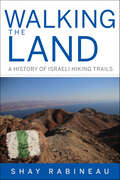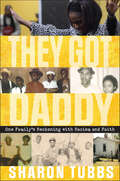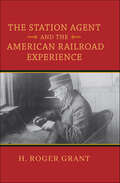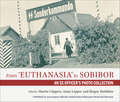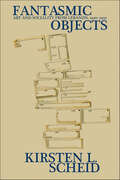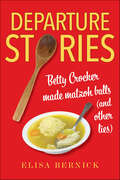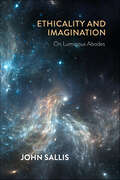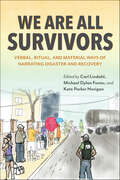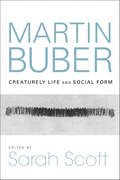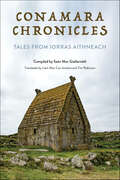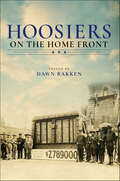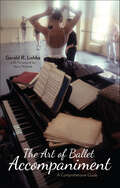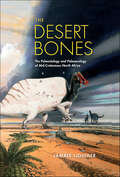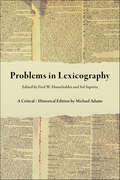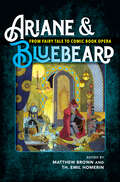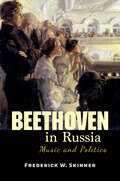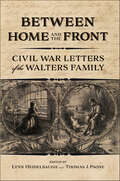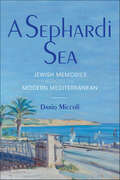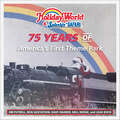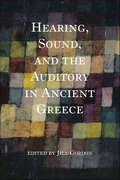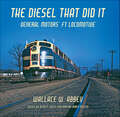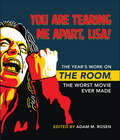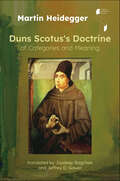- Table View
- List View
Walking the Land: A History of Israeli Hiking Trails (Perspectives on Israel Studies)
by Shay RabineauIsrael has one of the most extensive and highly developed hiking trail systems of any country in the world. Millions of hikers use the trails every year during holiday breaks, on mandatory school trips, and for recreational hikes. Walking the Land offers the first scholarly exploration of this unique trail system. Featuring more than ten thousand kilometers of trails, marked with hundreds of thousands of colored blazes, the trail system crisscrosses Israeli-controlled territory, from the country's farthest borders to its densest metropolitan areas. The thousand-kilometer Israel National Trail crosses the country from north to south. Hiking, trails, and the ubiquitous three-striped trail blazes appear everywhere in Israeli popular culture; they are the subjects of news articles, radio programs, television shows, best-selling novels, government debates, and even national security speeches. Yet the trail system is almost completely unknown to the millions of foreign tourists who visit every year and has been largely unstudied by scholars of Israel. Walking the Land explores the many ways that Israel's hiking trails are significant to its history, national identity, and conservation efforts.
They Got Daddy: One Family's Reckoning with Racism and Faith
by Sharon TubbsAn unforgettable journey through racism and faith across the generations. January 15, 1959—a day that changed one family forever. White supremacists kidnapped and severely beat rural Alabama preacher Israel Page, nearly killing him because he had sued a White sheriff's deputy for injuries suffered in a car crash. After "they" "got Daddy," Israel Page's children began leaving the Jim Crow South, the event leaving an indelible mark on the family and its future. Decades later, the events of that day fueled journalist Sharon Tubbs's epic quest to learn who had "gotten" her mother's daddy and why. They Got Daddy follows Tubbs on her moving journey from Fort Wayne, Indiana, to the back roads and rural churches of Alabama. A powerful revelation of the sustaining and redemptive power of faith and unflinching testimony to the deeply embedded effects of racism across the generations, it demonstrates how the search for the truth can offer a chance at true healing.
The Station Agent and the American Railroad Experience (Railroads Past and Present)
by H. Roger GrantBefore the widespread popularity of automobiles, buses, and trucks, freight and passenger trains bound the nation together. The Station Agent and the American Railroad Experience explores the role of local frontline workers that kept the country's vast rail network running.Virtually every community with a railroad connection had a depot and an agent. These men and occasionally women became the official representatives of their companies and were highly respected. They met the public when they sold tickets, planned travel itineraries, and reported freight and express shipments. Additionally, their first-hand knowledge of Morse code made them the most informed in town. But as times changed, so did the role of, and the need for, the station agent.Beautifully illustrated with dozens of vintage photographs, The Station Agent and the American Railroad Experience, brings back to life the day-to-day experience of the station agent and captures the evolution of railroad operations as technology advanced.
From "Euthanasia" to Sobibor: An SS Officer's Photo Collection
by Martin Cüppers, Anne Lepper and Jürgen MatthäusThe mass murder of the European Jews by Nazi Germany went hand in hand with the destruction of evidence attesting to this genocide. As Holocaust survivor Jules Schelvis puts it, "very few documents relating to Sobibor and the other death camps" remain. With its rich photographic imagery, the collection featured in From "Euthanasia" to Sobibor: An SS Officer's Photo Collection sheds new light on the Holocaust and other key aspects of Nazi extermination policy. The materials were compiled by Johann Niemann, an SS officer whose earlier participation in the Nazi "euthanasia" murders made him second-in-command at Sobibor and the first to get killed in the prisoner uprising of October 13, 1943. These documents allow crucial insights into the making of mass murderers, the evolution of the "final solution," and its consequences for the victims. As prevalent as the perpetrator perspective is in Niemann's collection, From "Euthanasia" to Sobibor offers a welcome corrective by complementing his images and documents with testimonies of Sobibor survivors, many of which also available in the US Holocaust Memorial Museum (USHMM) archives. With its compilation of unique primary sources and skillful explication, From "Euthanasia" to Sobibor addresses under-researched aspects of Nazi mass violence beyond the Holocaust and offers a rich resource for researching and teaching.Published in Association with the United States Holocaust Memorial Museum
Fantasmic Objects: Art and Sociality from Lebanon, 1920–1950 (Public Cultures Of The Middle East And North Africa Ser.)
by Kirsten L. ScheidIn Lebanon, the study of modern art—rather than power or hierarchy—has compelled citizens to confront how they define themselves as a postcolonial nation.In Fantasmic Objects, Kirsten L. Scheid offers a striking study of both modern art in Lebanon and modern Lebanon through art. By focusing on the careers of Moustapha Farrouk and Omar Onsi, forefathers of an iconic national repertoire, and their rebellious student Saloua Raouda Choucair, founder of an antirepresentational, participatory art, Scheid traces an emerging sense of what it means to be Lebanese through the evolution of new exhibition, pedagogical, and art-writing practices. She reveals that art and artists helped found the nation during French occupation, as the formal qualities and international exhibitions of nudes and landscapes in the 1930s crystallized notions of modern masculinity, patriotic femininity, non-sectarian religiosity, and citizenship. Examining the efforts of painters, sculptors, and activists in Lebanon who fiercely upheld aesthetic development and battled for new forms of political being, Fantasmic Objects offers an insightful approach to the history and formation of modern Lebanon.
Departure Stories: Betty Crocker Made Matzoh Balls (and Other Lies)
by Elisa Bernick"We weren't religious per se. The most frequent mention of God in our house was my mother yelling 'Goddammit!'"Elisa Bernick grew up "different" (i.e., Jewish) in the white, Christian suburb of New Hope, Minnesota during the 1960s and early 1970s. At the center of her world was her mother, Arlene, who was a foul-mouthed, red-headed, suburban Samson who ultimately shook the walls of their family until it collapsed. Poignant and provocative, Departure Stories peers through the broader lens of Minnesota's recent history to reveal an intergenerational journey through trauma that unraveled the Bernick family and many others.Deftly interweaving reporting, archival material, memoir, jokes, scrapbook fragments, personal commentary, and one very special Waikiki Meatballs recipe, Bernick explores how the invisible baggage of place and memory, Minnesota's uniquely antisemitic history, and the cultural shifts of feminism and changing marital expectations contributed to her family's eventual implosion. Departure Stories: Betty Crocker Made Matzoh Balls (and other lies) is a personal exploration of erasure, immigrants, and exiles that examines the ways departures—from places, families and memory—have far-reaching effects.
Ethicality and Imagination: On Luminous Abodes (The Collected Writings of John Sallis)
by John SallisEthicality and Imagination is the astounding conclusion to John Sallis's landmark trilogy launched with Force of Imagination and Logic of Imagination. In this new work,Sallis embarks on an unforgettable voyage spanning the cosmos and delving deep into what makes us human. If the first two works consider the question of being and thinking, respectively, the third and culminating volume takes up the question of action. In a series of highly original and always provocative meditations, Sallis articulates the way humans are rooted in their abodes yet not determined by them. Ethicality and Imagination develops a new approach to the relation of the imagination to literature, ethics, political thought, and recent discoveries in astrophysics. It represents a brilliant conclusion to one of the most exciting works of thinking in the Continental school in recent decades.
We Are All Survivors: Verbal, Ritual, and Material Ways of Narrating Disaster and Recovery
by Carl Lindahl, Michael Dylan Foster and Kate Parker HoriganWhat is the role of folklore in the discussion of catastrophe and trauma? How do disaster survivors use language, ritual, and the material world to articulate their experiences? What insights and tools can the field of folkloristics offer survivors for navigating and narrating disaster and its aftermath? Can folklorists contribute to broader understandings of empathy and the roles of listening in ethnographic work?We Are All Survivors is a collection of essays exploring the role of folklore in the wake of disaster. Contributors include scholars from the United States and Japan who have long worked with disaster-stricken communities or are disaster survivors themselves; individual chapters address Hurricane Katrina, Hurricane Maria, and two earthquakes in Japan, including the earthquake, tsunami, and nuclear disaster of 2011. Adapted from a 2017 special issue of Fabula (from the International Society for Folk Narrative Research), the book includes a revised introduction, an additional chapter with original illustrations, and a new conclusion considering how folklorists are documenting the COVID-19 pandemic.We Are All Survivors bears witness to survivors' expressions of remembrance, grieving, and healing.
Martin Buber: Creaturely Life and Social Form (New Jewish Philosophy and Thought)
by Sarah ScottA new collection of essays highlighting the wide range of Buber's thought, career, and activism. Best known for I and Thou, which laid out his distinction between dialogic and monologic relations, Martin Buber (1878–1965) was also an anthologist, translator, and author of some seven hundred books and papers. Martin Buber: Creaturely Life and Social Form, edited by Sarah Scott, is a collection of nine essays that explore his thought and career.Martin Buber: Creaturely Life and Social Form shakes up the legend of Buber by decentering the importance of the I-Thou dialogue in order to highlight Buber as a thinker preoccupied by the image of relationship as a guide to spiritual, social, and political change. The result is a different Buber than has hitherto been portrayed, one that is characterized primarily by aesthetics and politics rather than by epistemology or theology. Martin Buber: Creaturely Life and Social Form will serve as a guide to the entirety of Buber's thinking, career, and activism, placing his work in context and showing both the evolution of his thought and the extent to which he remained driven by a persistent set of concerns.
Conamara Chronicles: Tales from Iorras Aithneach (Irish Culture, Memory, Place)
by Seán Mac Giollarnáth"I find him to be a kindred spirit, a sympathetic but shrewd enquirer, a companionable stroller, and a lover of anecdotes gathered by the wayside." So Tim Robinson described folklorist, revolutionary, and district justice Seán Mac Giollarnáth, whose 1941 book Annála Beaga ó Iorras Aithneach revealed his sheer delight in the rich language and stories of the people he encountered in Conamara, the Irish-speaking region in the south of Connemara. From tales of smugglers, saints, and scholars to memories of food, work, and family, the stories gathered here provide invaluable insights into the lives and culture of the community. This faithful and lovingly crafted translation, complete with annotations, a biography, and thoughtful chapters that explore the importance of the language and region, is the final work of both Robinson and his collaborator, the renowned writer and Irish language expert Liam Mac Con Iomaire. Translated into English for the first time, Conamara Chronicles: Tales from Iorras Aithneach preserves the art of storytellers in the West of Ireland and honors the inspiration they kindle even still.
Hoosiers on the Home Front
by Dawn BakkenWars are fought on the home front as well as the battlefront. Spouses, family, friends, and communities are called upon to sacrifice and persevere in the face of a changed reality. Hoosiers on the Home Front explores the lives and experiences of ordinary Hoosiers from around Indiana who were left to fight at home during wartimes. Drawn from the rich holdings of the Indiana Magazine of History, a journal of state and midwestern history published since 1905, this collection includes original diaries, letters and memoirs, and research essays—all focused on Hoosiers on the home front of the Civil War through the Vietnam War. Readers will meet, among others, Joshua Jones of the 19th Indiana Volunteer Regiment and his wife, Celia; Attia Porter, a young resident of Corydon, Indiana, writing to her cousin about Morgan's Raid; Civil War and World War I veterans who came into conflict over the Indianapolis 500 and Memorial Day observances; Virginia Mayberry, a wife and mother on the World War II home front; and university students and professors—including antiwar activist Howard Zinn and conservative writer R. Emmett Tyrrell Jr.—clashing over the Vietnam War.Hoosiers on the Home Front offers a compelling glimpse of how war impacts everyone, even those who never saw the front line.
The Art of Ballet Accompaniment: A Comprehensive Guide
by Gerald R. LishkaThe Art of Ballet Accompaniment: A Comprehensive Guide addresses every imaginable topic and challenge that a ballet accompanist—whether a novice or a more experienced practitioner—might encounter.More than just a facile anthology of accessible music, this inclusive guide details all aspects of playing for ballet, including a complete manual for editing piano literature to accompany ballet technique classes. Author Gerald R. Lishka encourages ballet accompanists to be imaginative, creative, independent artists who can also communicate effectively with dance instructors. In addition, he clarifies the necessary balance between the use of existing musical scores and the art of improvisation. Featuring a new foreword by Kyra Nichols, an expanded section on Lishka's personal philosophy, an updated section on barre from Alison Hennessey, and over 100 music examples, The Art of Ballet Accompaniment offers invaluable advice for all levels of pianists and accompanists.
The Desert Bones: The Paleontology and Paleoecology of Mid-Cretaceous North Africa (Life of the Past)
by Jamale IjouiherAn essential introduction to the age of dinosaurs in Africa.Once Africa was referred to as the ''Lost World of the dinosaur era,'' so poorly known were its ancient flora and fauna. Worse still, many priceless fossil specimens from the Sahara Desert were destroyed during the Second World War. Fortunately, in the twentieth-first century, more researchers are now working in north Africa than ever before and making fascinating discoveries such as the dinosaur Spinosaurus. Based on a decade of study, The Desert Bones brings the world of African dinosaurs fully into the light. Jamale Ijouiher skillfully draws on the latest research and knowledge about paleoecology to paint a compelling and comprehensive portrait of the mid-Cretaceous in North Africa.
Problems in Lexicography: A Critical/Historical Edition (Well House Bks.)
by Michael AdamsProblems in Lexicography is an essential, classic work of practical lexicography (the practice of writing dictionaries) and meta-lexicography. Originally published over sixty years ago, it was based on the proceedings of the Indiana University Conference on Lexicography, held November 11–12, 1960. It set a standard that still holds today, three generations later. This critical and historical edition, brilliantly researched and presented by Michael Adams, explores the enduring legacy of this classic work and promises to extend its life further into the twenty-first century. Problems in Lexicography: A Critical / Historical Edition amply demonstrates that this unique work is a book of historical significance and a worthy prologue to lexicography's present.
Ariane & Bluebeard: From Fairy Tale to Comic Book Opera
by Matthew Brown and Th. Emil HomerinMaurice Maeterlinck described his libretto Ariane et Barbe-bleue as "a sort of legendary opera, or fairy [opera], in three acts." In 1907, Paul Dukas finished setting Maeterlinck's libretto to music, and the opera's Paris premiere was lauded as a landmark in operatic history. Ariane & Bluebeard: From Fairy Tale to Comic Book Opera offers a comprehensive, interdisciplinary look at this historic opera, including its structure, reception, and cultural implications. This lively collection juxtaposes chapters from experts in music, literature, the visual arts, gender studies, and religion and philosophy with vibrant illustrations by comic artist P. Craig Russell and interviews with performers and artists. Featuring material from newly discovered documents and the first English translation of several important sources, Ariane & Bluebeard allows readers to imagine the operain its various incarnations: as symbolist show, comic book, children's fairy tale, and more.
Beethoven in Russia: Music and Politics
by Frederick W. SkinnerHow did Ludwig van Beethoven help overthrow a tsarist regime? With the establishment of the Russian Musical Society and its affiliated branches throughout the empire, Beethoven's music reached substantially larger audiences at a time of increasing political instability. In addition, leading music critics of the regime began hearing Beethoven's dramatic works as nothing less than a call to revolution. Beethoven in Russia deftly explores the interface between music and politics in Russia by examining the reception of Beethoven's works from the late 18th century to the present. In part 1, Frederick W. Skinner's clear and sweeping review examines the role of Beethoven's more dramatic works in the revolutionary struggle that culminated in the Revolution of 1917. In part 2, Skinner reveals how this same power was again harnessed to promote Stalin's campaign of rapid industrialization. The appropriation of Beethoven and his music to serve the interests of the state remained the hallmark of Soviet Beethoven reception until the end of communist rule. With interdisciplinary appeal in the areas of history, music, literature, and political thought, Beethoven in Russia shows how Beethoven's music served as a call to action for citizens and weaponized state propaganda in the great political struggles that shaped modern Russian history.
Between Home and the Front: Civil War Letters of the Walters Family
by Lynn Heidelbaugh and Thomas J. PaoneThe personal letters of Americans during the Civil War preserve first-person records of news, people, and emotions that humanize the horrific events of the war and provide unique insights into the conflict's effects on individuals, families, communities, and America. Often, however, only the letters sent home survived, leaving half of the story missing. Between Home and the Front presents previously unpublished letters from the Walters family's collection held by the Smithsonian's National Postal Museum, which include the exchange of correspondence between the home front and front line, a perspective not often seen.Between Home and the Front gives us a glimpse into the poignant questions, answers, and sentiments Private David Walters of the 5th Indiana Calvary and his wife Rachel shared in their correspondence. The letters from David give details about some of the lesser-known actions of the western theater of combat, such as Morgan's Raid. The letters by Rachel Walters record how she managed the household and a young child while becoming hub of communication for the family, often receiving missives from David's brothers, Isaac and John Wesley, both of whom served with Indiana units, and relaying the information to others. From the early letters describing a Civil War soldier's enlistment to his widow's struggle in the aftermath of the war, the letters of the Walters family add incomparable details to the study of the Civil War. Between Home and the Front offers not only unique first-person accounts from those that experienced the Civil War but also meticulous annotations that provide valuable historical context for the events, people, and material culture described in the letters.
A Sephardi Sea: Jewish Memories across the Modern Mediterranean (Sephardi and Mizrahi Studies)
by Dario MiccoliA Sephardi Sea tells the story of Jews from the southern shore of the Mediterranean who, between the late 1940s and the mid-1960s, migrated from their country of birth for Europe, Israel, and beyond. It is a story that explores their contrasting memories of and feelings for a Sephardi Jewish world in North Africa and Egypt that is lost forever but whose echoes many still hear. Surely, some of these Jewish migrants were already familiar with their new countries of residence because of colonial ties or of Zionism, and often spoke the language. Why, then, was the act of leaving so painful and why, more than fifty years afterward, is its memory still so tangible?Dario Miccoli examines how the memories of a bygone Sephardi Mediterranean world became preserved in three national contexts—Israel, France, and Italy—where the Jews of the Middle East and North Africa and their descendants migrated and nowadays live.A Sephardi Sea exploreshow practices of memory- and heritage-making—from the writing of novels and memoirs to the opening of museums and memorials, the activities of heritage associations and state-led celebrations—has filled an identity vacuum in the three countries and helps the Jews from North Africa and Egypt to define their Jewishness in Europe and Israel today but also reinforce their connection to a vanished world now remembered with nostalgia, affection, and sadness.
Holiday World & Splashin' Safari: 75 Years of America's First Theme Park
by Jim Futrell Dave Hahner Ron Gustafson Nell HedgeAmerica's first theme park, Holiday World & Splashin' Safari, is one of the largest family-owned and -operated independent parks in the United States, and its success is no accident. From moving Interstate 64 closer to the small town to introducing free unlimited soft drinks, four generations of the Koch family have amplified the legacy of this iconic Indiana attraction.Holiday World & Splashin' Safari celebrates the history of the Koch family and Santa Jim Yellig; the origins of Santa Claus, Indiana; and the early years of Santa Claus Land. The story continues with the expansion from Santa Claus Land to Holiday World, the addition of the park's famous trio of top-ranked wooden roller coasters, and the development of Splashin' Safari Water Park, ranked one of the top water parks in the country. For three-quarters of a century, the Koch family has launched the park into worldwide renown and national recognition. Featuring over 100 color illustrations, Holiday World & Splashin' Safari relives this joyous past while looking forward to the thrills fans can expect in the next 75 years.
Night without End: The Fate of Jews in German-Occupied Poland (Studies in Antisemitism)
by Jan Grabowski and Barbara EngelkingThree million Polish Jews were murdered in the Holocaust, wiping out nearly 98 percent of the Jewish population who had lived and thrived there for generations. Night Without End tells the stories of their resistance, suffering, and death in unflinching, horrific detail. Based on meticulous research from across Poland, it concludes that those who were responsible for so many deaths included a not insignificant number of Polish villagers and townspeople who aided the Germans in locating and slaughtering Jews.When these findings were first published in a Polish edition in 2018, a storm of protest and lawsuits erupted from Holocaust deniers and from people who claimed the research was falsified and smeared the national character of the Polish people.Night Without End, translated and published for the first time in English in association with Yad Vashem, presents the critical facts, significant findings, and the unmistakable evidence of Polish collaboration in the genocide of Jews.
Hearing, Sound, and the Auditory in Ancient Greece (Studies in Continental Thought)
by Jill GordonHearing, Sound, and the Auditory in Ancient Greece represents the first wide-ranging philosophical study of the role of sound and hearing in the ancient Greek world. Because our modern western culture is a particularly visual one, we can overlook the significance of the auditory which was so central to the Greeks. The fifteen chapters of this edited volume explore "hearing" as being philosophically significant across numerous texts and figures in ancient Greek philosophy. Through close analysis of the philosophy of such figures as Homer, Heraclitus, Pythagoreans, Sophocles, Empedocles, Socrates, Plato, Aristotle, Hearing, Sound, and Auditory in Ancient Greece presents new and unique research from philosophers and classicists that aims to redirect us to the ways in which sound, hearing, listening, voice, and even silence shaped and reflected the worldview of ancient Greece.
The Diesel That Did It: General Motors' FT Locomotive (Railroads Past and Present)
by Wallace W. AbbeyThe Diesel That Did It tells the story of the legendarydiesel-electric locomotive, the FT.As war loomed in 1939, American railroads were on the precipice of railroad transformation. In an obscure factory in La Grange, Illinois, a group of gifted engineers and designers were planning a revolution that would shake railroading to its foundations and eventually put the steam locomotive out of business. Their creation, the FT, was a diesel-electric, semi-streamlined freight engine. The FT would establish a new standard for reliability, flexibility, and cost, but its arrival unsettled many railroad employees and gave fresh ammunition to their labor unions, who believed that it threatened a century-old culture.Wallace W. Abbey's The Diesel That Did It is the story of a revolution. He explores how EMC (and its successor Electro-Motive Division of General Motors) conceived the FT, and how it ultimately emerged as the dominant locomotive power plant for 20 years. However, for Abbey, the history of the Santa Fe Railway and the FT go hand in hand. The Diesel That Did It also offers a penetrating look at how the great American railroad, at the height of its Super Chief glamor, threw its conservative mechanical traditions aside to bet big on the diesel. Showcasing more than 140 exquisite photographs by Abbey and other noted photographers, The Diesel That Did It is a captivating story not to be missed by railroaders and railfans.
From AIDS to Population Health: How an American University and a Kenyan Medical School Transformed Healthcare in East Africa (Well House Bks.)
by James D. KellyFrom AIDS to Population Health explores the thirty-year history of a unique collaboration between the medical schools of Indiana University and Moi University in Kenya, as it progressed from combating the HIV/AIDS epidemic in East Africa to the building of a national plan to provide universal healthcare to all. The Academic Model Providing Access to Healthcare (AMPATH) program focuses on the medical education of healthcare professionals who are building communities that can take care of themselves.The overwhelming success of the AMPATH program and its continuing vibrant legacy today are showcased through dozens of striking photographs, telling interviews, and revealing anecdotes and encounters. It focuses on four of the most innovative projects among the fifty that AMPATH oversees: a microfinance officer who organizes villagers, an oncology nurse who runs outreach clinics, a farm extension agent working in partnership with a multinational agriculture corporation to improve farm output, and a special healthcare clinic exclusively for adolescents.Over its thirty-year history, AMPATH has served more than a million clients and trained 2,600 medical professionals and community health workers, always guided by its motto "Leading with Care." From AIDS to Population Health presents their compelling stories and explores the program's continuing legacy for the first time.
You Are Tearing Me Apart, Lisa!: The Year's Work on The Room, the Worst Movie Ever Made (The Year's Work)
by Adam M. RosenWhen released in 2003, The Room, an obscure, self-financed relationship drama by an eccentric self-taught filmmaker named Tommy Wiseau, should have been completely forgotten. Yet nearly two decades later, "the worst movie ever made"—as many a critic would have it—has become the most popular cult film since The Rocky Horror Picture Show.In You Are Tearing Me Apart, Lisa!, contributors explore this priceless cultural artifact, offering fans and film buffs critical insight into the movie's various meanings, historical context, and place in the cult canon. Even if by complete accident, The Room touches on many issues of modern concern, including sincerity, authenticity, badness, artistic value, gender relations, Americanness, Hollywood conventions, masculinity, and even the meaning of life. Revealing the timeless, infamous power of Wiseau's The Room, You Are Tearing Me Apart, Lisa! is a deeply entertaining deconstruction of an original work of all-American failure.
Duns Scotus's Doctrine of Categories and Meaning (Studies in Continental Thought)
by Martin HeideggerDuns Scotus's Doctrine of Categories and Meaning is a key text for the origins of Martin Heidegger's concept of "facticity." Originally submitted as a postdoctoral thesis in 1915, it focuses on the 13th-century philosopher-theologian John Duns Scotus. Heidegger first analyzes Scotus's doctrine of categories, then offers a meticulous explanation of the Grammatica Speculativa, a work of medieval grammar now known to be authored by the Modist grammarian Thomas of Erfurt. Taken together, these investigations represent an early foray into Heidegger's lifelong philosophical concerns, "the question of being in the guise of the problem of categories and the question of language in the guise of the doctrine of meaning."This new and unique translation of one of Heidegger's earliest works offers an important look at his early thinking before the question of being became his central concern and will appeal to readers exploring Heidegger's philosophical development, medieval philosophy, phenomenological interpretations of the history of philosophy, and the philosophy of language.
